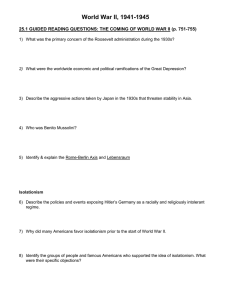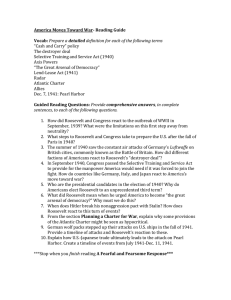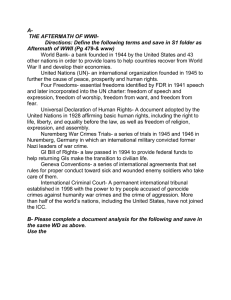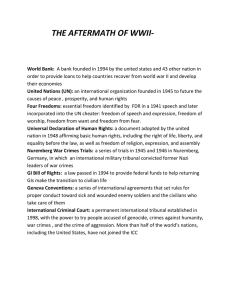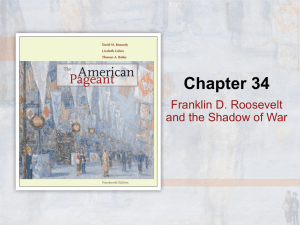Document 15978456
advertisement
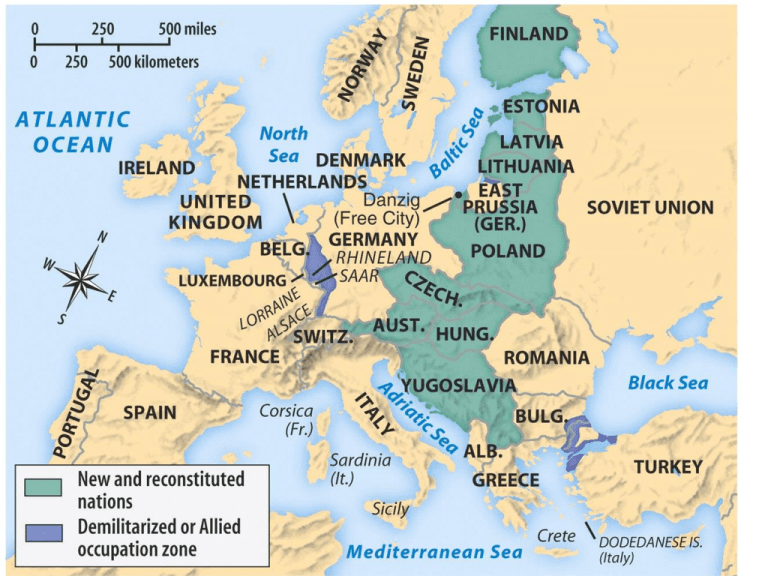
Russian Civil War Wall Street Bomb in 1920 killed 38 and seriously injured 143. Red Summer of 1919 White mobs attacked African Americans in 25 cities. Worst riots were in Chicago, Washington, D.C., and Elaine, Arkansas. Tulsa Race Riot of 1921 At least 39 killed Election Of 1920 • Ford Model T • Ford Model A The 1929 Graham Paige DC Phaeton shown here featured an 8-cylinder engine and an aluminum body. 1927 Buick Master Six Brougham Sedan 1927 Duesenberg Model X Sedan Made in Indiana 1933 Packard Twelve Five-Passenger Sport Phaeton 1933 Pierce-Arrow V12 Convertible Coupe Fallingwater, by Frank Lloyd Wright Unity Temple, Frank Lloyd Wright Art Deco Laurel and Hardy Charlie Chaplin Buster Keaton W. C. Fields Roscoe “Fatty” Arbuckle Alice White Greta Garbo Gloria Swanson Fay Wray Mary Pickford Clara Bow Douglas Fairbanks, Sr. Will Rogers Rudolph Valentino John Barrymore Tom Mix Josephine Baker Culture Wars of the 1920s 1. Prohibition 2. Role of Women 3. Resurgence of the Ku Klux Klan 4. Evolution Prohibition, 1920-1933 Per Capita Consumption of Alcoholic Beverages (Gallons of Pure Alcohol) 1910-1929. Murder Rate Prohibition presented lucrative opportunities for organized crime to take over the importing ("bootlegging"), manufacturing, and distributing of alcoholic drinks. Al Capone was able to build his criminal empire largely on profits from illegal alcohol. Saint Valentine’s Day Massacre, 1929 Seven members of Moran’s gang gunned down by Capone’s gang Feminine Tippler's Ankle Flask, 1922 "The National Gesture," 1926 2. Role of Women Resurgence of the Ku Klux Klan, 1915-1929 As many as 4 million members in 1924 Ku Klux Klan on Parade, 1928 Clarence Darrow at the Scopes Evolution Trial, 1925 Warren G. Harding, President 1921-1923 Calvin Coolidge, President, 1923-1929 Herbert Hoover, President, 1929-1933 Unemployment rate 25 20 15 10 5 0 ’29 ’30 ’31 ’32 ’33 ’34 ’35 ’36 ’37 ’38 ’39 ’40 ’41 ‘42 Dorothea Lange's Migrant Mother depicts destitute pea pickers in California, centering on Florence Owens Thompson, a mother of seven children, age thirty-two, in Nipomo, California, March 1936. "Community Camp", a depression era shanty town, Oklahoma City, Oklahoma Dorothea Lange; Abandoned farm. near Dalhart, Texas Arkansas girl in migrant camp near Greenfield, California. This is an Arkansawyers auto camp. Rent ten dollars per month for one room, iron bed, electric light. (Dorothea Lange) Dorothea Lange; White Angel Bread Line, San Francisco; 1933 Cotton hoers loading at Memphis, Tennessee for the day's work in Arkansas. June 1937. Ozark family in Depression Dust Bowl in Oklahoma • Ozark family home Sharecropper’s family in Washington County, Arkansas Boone Co., Arkansas A “Hooverville” outside Seattle • Negroes waiting for food in the Forrest City, Arkansas, concentration camp; 1937 • Evicted sharecroppers Bonus Army shacks burning Franklin D. Roosevelt President, 1933-1945 Franklin D. Roosevelt, Eleanor Roosevelt, and John R. in Albany, New York, 1930 Franklin D. Roosevelt and the New Deal • FDIC • AAA • CCC – Devil’s Den; Petit Jean • CWA and WPA • REA • Social Security Fireside Chats Devil’s Den State Park • Dedication of University of Arkansas stadium; built by WPA in 1938 1934 • CCC; planting trees Eleanor Roosevelt in Los Angeles, California, 1933 Eleanor Roosevelt's Travels, 1936-1937 Tennessee Valley Authority Great Movies 1935-1946 • • • • 1935 A Night at the Opera (Marx Brothers) 1936 Modern Times (Charlie Chaplin) 1937 Snow White and the Seven Dwarves 1938 The Adventures of Robin Hood 1939 – Hollywood’s Golden Year • • • • • • • 1940 Rebecca (Alfred Hitchcock) 1940 The Grapes of Wrath 1940 The Philadelphia Story 1941 Citizen Kane 1941 The Maltese Falcon 1942 Casablanca 1946 It’s a Wonderful Life May 6, 1937 Hindenburg Disaster Separated at birth? Saddam Hussein Stalin Benito Mussolini “Il Duce” Hitler in 1931 First they came for the communists, and I did not speak out-because I was not a communist; Then they came for the socialists, and I did not speak out-because I was not a socialist; Then they came for the trade unionists, and I did not speak out-because I was not a trade unionist; Then they came for the Jews, and I did not speak out-because I was not a Jew; Then they came for me-and there was no one left to speak out for me. Martin Niemoeller, German minister and opponent of Nazis who spent seven years in a concentration camp Spanish Civil War 1936-1939 Hitler in May 1937 Adolf Hitler “Der Fuhrer” Man of the Year 1938 - Hitler German Expansion, 1936-1939 Hitler in April 1941 Messerschmitt Bf 109 Heinkel He 111 over London, 7 September 1940 Bombing of London, 1940 1940 Churchill Hurricane Spitfire Winston Churchill, Franklin D. Roosevelt, F.D.R. Jr., and Elliott R. at the Atlantic Conference, August 1941 Churchill and Roosevelt at Casablanca, 1943 1941 – Franklin D. Roosevelt The Four Freedoms FDR, Jan. 1941 Painted by Norman Rockwell 1. Freedom of Speech 2. Freedom to Worship 3. Freedom from Want 4. Freedom from Fear Nazi aggression to 1941 Pearl Harbor, December 7, 1941 Japanese “Zero” Grumman F4F3 US Navy Fighter Lockheed P-38 Lightning P-51A Mustang American B-17s (Flying Fortresses) flew in elaborate formations to concentrate defensive machine gun fire. B-24 Liberator B-29 Superfortress Sherman tank Panzer IV Jerome Relocation Camp Franklin D. Roosevelt, General William Wilbur; General Marshall, and General Patton in Casablanca , 1943 The Big Three: Churchill, Roosevelt, Stalin (Yalta, 1945) Normandy Invasion D-Day June 6, 1944 Key Military Leaders Europe • Eisenhower was Supreme Commander – B. L. Montgomery, British Field Marshal – George Patton – Omar Bradley • German General: Erwin Rommel Russians take Berlin May 2, 1945 Harry S. Truman President, 1945-1953 The Expansion of Japan, 1931-1941 Pacific Theater • General Douglas MacArthur • Admiral Chester Nimitz Douglas MacArthur coming ashore in 1944 Kamikaze attack off Okinawa Atomic bombs dropped Hiroshima – August 6, 1945 Nagasaki – August 9, 1945 Japan surrenders on September 2, 1945 Chester Nimitz signs Japan’s surrender V-J Day August 15, 1945 People movements after World War II United Nations Oct. 24, 1945 15 members of Security Council 5 permanent members: U.S., Russia, U.K., France, China 1948: Universal Declaration of Human Rights Dresden, Germany in 1945 Countries that received Marshall Plan aid Berlin Airlift, 1948 Chinese Civil War Baby Boom, 1946-1964 Joseph McCarthy, senator from Wisconsin Election Of 1948 Stage 1: North Korea attacks Stage 2: Americans pushed to Pusan Perimeter Stage 3: Inchon Stage 4: Approaching the Yalu Stage 5: China enters the war Stage 6: Stalemate U.S. Atomic Tests, 1945-1962 The Military-Industrial Complex, 1952 The Military-Industrial Complex in Los Angeles
